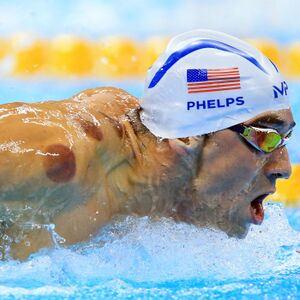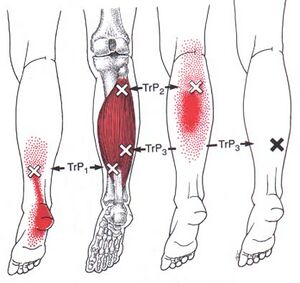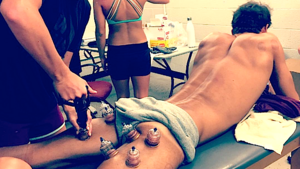Modern Cupping from Clinical Approach
This article is currently under review and may not be up to date. Please come back soon to see the finished work! (30/04/2023)
Top Contributors - {{Special:Contributors/Template:Modern Cupping from Clinical Approach}}
Introduction[edit | edit source]
Cupping Therapy is a universal practice in the east and west[1], where it's popularity has been spanned in the modern communities when Michael Phelps-Olympic gold medal winner, was seen with cupping marks in Rio de Janeiro in Brazil 2016[2]. Cupping Therapy is an alternative medicine that sometimes referred to suction therapy based on it's mechanism of action or Myo-fascial Decompression Therapy[3]. Different types of cupping therapy have been used to treat many diseases with different conditions that included improvement of sports performance[2].
Updated classification of cupping therapy is developed and more types of cupping therapy are categorised, this 6 criteria classification includes [4][5]: Area treated category, material inside the cups and sixth category is other cupping types for example: sports, cosmetic, and aquatic cupping[5].
Evidence to date:[edit | edit source]
An overview of systematic reviews assessed the safety and effectiveness of cupping therapy for 11 disease through an evidence based approach[6]. Results of multiple systematic reviews showed that cupping therapy (alone or combined with other interventions) was better than medications (or other interventions alone) for different diseases included cervical spondylosis and low back pain, although one review reported adverse effects like increase in pain and tingling after cupping treatment[6]Overall, Cupping may be beneficial for pain relief[6][7], On the other note, the insufficient number of reviews and the poor qualities of the original studies couldn't firm the conclusive results[6][8].
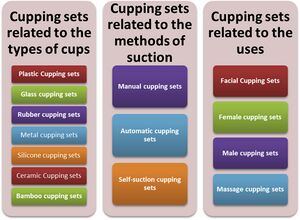
The mechanism of action of cupping therapy was not clear until now [7].No single theory explains the whole effects of it[9]
Different types of cupping sets were used in previous studies studies[4].In an updated review, studies used dry cupping the most, followed by wet cupping[10]. Most studies compared cupping therapy to non-intervention,other studies compared cupping to standard medical care, heat, routine physiotherapy, electrical stimulation, active range of motion and stretching, passive stretching, or acetaminophen. Treatment duration ranged from 1 day to 12 weeks. The level of evidence of cupping is increasing on soft tissue flexibility to moderate. Its effect on decreasing low back pain or cervical pain is low to moderate. About treating other musculoskeletal conditions is very low to low. Finally, the incidence of adverse events is very low[10]
Benefits on MSK problems[edit | edit source]
Cupping may be an effective tool with low risk in treating nonspecific, musculoskeletal pain like back, neck and shoulders[7].This is also has been further concluded in the results of further concise review[11]
RCT investigated the outcomes of Dry cupping on pain and function for patients with planter heal pain using cups on calf muscle myo-fascial trigger points (MTrPs)[13]. Research concluded that adding dry cupping on calf MTrPs to self-stretching and ankle dorsiflexion exercises for those patients was superior to only self-stretching and active ankle dorsiflexion exercises, ankle dorsiflexion ROM, and plantar flexor strength[13][14]. Self stretching was performed with the cup placed on calf trigger point for 20 seconds followed by 20 seconds rest for 3 minutes .Outcome measures were visual analogue scale (VAS), pressure pain threshold (PPT), and patient-specific functional scale (PSFS). Also secondary outcomes were ankle dorsiflexion range of motion (ROM) and ankle plantar flexor strength. Results showed improvements in those outcomes when measures were assessed immediately after the session and after 2 days[13][15]. Future research is still recommended to address the long term efficacy of this technique as the absence of placebo group in this RCT is considered as one of the study limitations[16].
Same idea can be applied for planter foot pain of neural origin with adding neural glides of the lower quarter and the cupping is placed in the saphenous nerve course as reported in 65 year old case study[17].
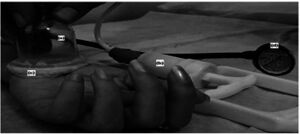
Cupping therapy has therapeutic effects in treatment of Carpal Tunnel Syndrome[18]. Studies that support cupping effects on CTS are growing over the past decade[19]. The treatment was safe and tolerable when Cupping are applied on related shoulder zones that appeared to alleviate the symptoms of carpal tunnel syndrome[18].

Post partum low back pain: Comparison between Dry cupping and acupressure at the acupuncture point BL23 was assessed in an RCT using McGill Pain Questionnaire Form[20]. Cupping was applied 15-20 minutes for 4 sessions per week, day on day off basis. It was followed by the acupuncture treatment for 20 minutes on circular model.
Data was gathered immediately, after 24 hours and following 2 weeks. The results showed pain relief effects for the two modalities[20].
Benefits on Respiratory system[edit | edit source]
cough reflex,
Benefits on Lymphatic system[edit | edit source]
Proposed mechanisms of actions have suggested effects of sub-atmospheric pressure suction, promoting peripheral blood circulation, and improving immunity[21]
swelling, CRC cancer, scar tissue
Benefits on sports performance[edit | edit source]
When reporting on the use of cupping among elite athletes, the National Broadcasting Company stated that cupping is a “therapy technique that athletes use to help their muscles recover and perform at their best[22]. Cupping is used for sports injuries such as congestion, swelling and spasm. Additionally, it plays a role as an analgesia and elimination of the cause of injury [23]
Hamstring Pathology: Immediate effects of cupping therapy on hamstring mild strain, tightness and decreased flexibility; compared to that of self myo-fascial release were evaluated through a pilot randomised trial[24]. Patients of first group received 3 minutes of static treatment of 6 plastic-valve suction cups along the hamstrings muscles, followed by 20 repetitions of active movement with cups remained in place[24]. The other group received 10 minutes of heat treatment over the hamstrings followed by 60 seconds of hamstring muscle mobilisation, and 90 seconds of targeted foam rolling on the area of most perceived tightness. Outcome measures included passive hamstring flexibility ROM and Perceived Functional Ability Questionnaire (PFAQ) that were recorded before and after the treatment session. Global Rating of Change measure (GROC) was measured after the session. Both treatment were benificial but study favoured the MFD group for the better scores resulted in the GROC measures[24]. However, further updated critical appraisal concluded that there's no enough high evidence that supports the use of MFD to increase hamstring flexibility and it's only level B evidence that supported the effectiveness of cupping at increasing the hamstring flexibility[25]
ITB , Planter fascia-ties, hamstrings, shin splint.
Case Scenario[edit | edit source]
Conclusion[edit | edit source]
Resources[edit | edit source]
- bulleted list
- x
or
- numbered list
- x
References[edit | edit source]
- ↑ Zhang H, Zhao M, Wu Z, Wang X, Jiang Y, Liang J, et al. Effects of acupuncture, moxibustion, cupping, and massage on sports injuries: A narrative review. Evid Based Complement Alternat Med [Internet]. 2022 [cited 2023 Apr
- ↑ 2.0 2.1 Musumeci G. Could cupping therapy be used to improve sports performance?. Journal of Functional Morphology and Kinesiology. 2016 Oct 27;1(4):373-7.
- ↑ References 1.Warren AJ, LaCross Z, Volberding JL, O’Brien MS. Acute outcomes of myofascial decompression (cupping therapy) compared to self-myofascial release on hamstring pathology after a single treatment. Int J Sports Phys Ther [Internet]. 2020;15(4):579–92. Available from: http://dx.doi.org/10.26603/ijspt20200579
- ↑ 4.0 4.1 Aboushanab TS, AlSanad S. Cupping therapy: an overview from a modern medicine perspective. Journal of acupuncture and meridian studies. 2018 Jun 1;11(3):83-7.
- ↑ 5.0 5.1 Al-Bedah AM, Aboushanab TS, Alqaed MS, Qureshi NA, Suhaibani I, Ibrahim G, Khalil M. Classification of cupping therapy: a tool for modernization and standardizaJournal of Complementary and Alternative Medical Research.tion. 2016 Jun;1(1):1-0.
- ↑ 6.0 6.1 6.2 6.3 Cao H, Han M, Zhu X, Liu J. An overview of systematic reviews of clinical evidence for cupping therapy. Journal of Traditional Chinese Medical Sciences. 2015 Jan 1;2(1):3-10.
- ↑ 7.0 7.1 7.2 Cao H, Li X, Liu J. An updated review of the efficacy of cupping therapy. PloS one. 2012 Feb 28;7(2):e31793.
- ↑ Cao H, Li X, Yan X, Wang NS, Bensoussan A, Liu J. Cupping therapy for acute and chronic pain management: a systematic review of randomized clinical trials. Journal of Traditional Chinese Medical Sciences. 2014 Jul 1;1(1):49-61.
- ↑ Al-Bedah AM, Elsubai IS, Qureshi NA, Aboushanab TS, Ali GI, El-Olemy AT, Khalil AA, Khalil MK, Alqaed MS. The medical perspective of cupping therapy: Effects and mechanisms of action. Journal of traditional and complementary medicine. 2019 Apr 1;9(2):90-7.
- ↑ 10.0 10.1 Mohamed AA, Zhang X, Jan YK. Evidence-based and adverse-effects analyses of cupping therapy in musculoskeletal and sports rehabilitation: A systematic and evidence-based review. Journal of Back and Musculoskeletal Rehabilitation. 2023 Jan 1;36(1):3-19.
- ↑ Trofa DP, Obana KK, Herndon CL, Noticewala MS, Parisien RL, Popkin CA, Ahmad CS. The evidence for common nonsurgical modalities in sports medicine, Part 2: Cupping and blood flow restriction. JAAOS Global Research & Reviews. 2020 Jan;4(1).
- ↑ [1]
- ↑ 13.0 13.1 13.2 AlKhadhrawi N, Alshami A. Effects of myofascial trigger point dry cupping on pain and function in patients with plantar heel pain: A randomized controlled trial. Journal of bodywork and movement therapies. 2019 Jul 1;23(3):532-8.
- ↑ Renan-Ordine, R., Alburquerque-SendÍn, F., Rodrigues De Souza, D.P., Cleland, J.A. and Fernández-De-Las-Penas, C., 2011. Effectiveness of myofascial trigger point manual therapy combined with a self-stretching protocol for the management of plantar heel pain: a randomized controlled trial. Journal of orthopaedic & sports physical therapy, 41(2), pp.43-50.
- ↑ Emerich M, Braeunig M, Clement HW, Lüdtke R, Huber R. Mode of action of cupping—local metabolism and pain thresholds in neck pain patients and healthy subjects. Complementary therapies in medicine. 2014 Feb 1;22(1):148-58.
- ↑ Lee MS, Kim JI, Kong JC, Lee DH, Shin BC. Developing and validating a sham cupping device. Acupuncture in Medicine. 2010 Dec;28(4):200-4.
- ↑ Holme JB, Skajaa K, Holme K. Incidence of lesions of the saphenous nerve after partial or complete stripping of the long saphenous vein. Acta chirurgica scandinavica. 1990 Feb 1;156(2):145-8.
- ↑ 18.0 18.1 Michalsen A, Bock S, Lüdtke R, Rampp T, Baecker M, Bachmann J, Langhorst J, Musial F, Dobos GJ. Effects of traditional cupping therapy in patients with carpal tunnel syndrome: a randomized controlled trial. The journal of pain. 2009 Jun 1;10(6):601-8.
- ↑ Farhat A, Mughal SM. Is There a Role of Cupping Therapy in the Treatment of Carpal Tunnel Syndrome in Primary Care Setting?. Cureus. 2021 Jan 28;13(1).
- ↑ 20.0 20.1 Yazdanpanahi Z, Ghaemmaghami M, Akbarzadeh M, Zare N, Azisi A. Comparison of the effects of dry cupping and acupressure at acupuncture point (BL23) on the women with postpartum low back pain (PLBP) based on short form McGill pain questionnaires in Iran: a randomized controlled trial. Journal of family & reproductive health. 2017 Jun;11(2):82.
- ↑ Zeng K, Wang JW. Clinical application and research progress of cupping therapy. Journal of Acupuncture and Tuina Science. 2016;4(14):300-4.
- ↑ Olympics NB. Why does Michael Phelps have purple spots on his back.
- ↑ 2.Lin G, Li L. Research progress of cupping therapy for myofascial trigger points. Chinese Journal of Ethnomedicine and Ethnopharmacy. 2019;28(22):83–5.
- ↑ 24.0 24.1 24.2 Warren AJ, LaCross Z, Volberding JL, O’Brien MS. Acute outcomes of myofascial decompression (cupping therapy) compared to self-myofascial release on hamstring pathology after a single treatment. International Journal of Sports Physical Therapy. 2020 Aug;15(4):579.
- ↑ 2.Spellman J, Eldredge R, Nelson M, Ostrowski J, Concannon J. Is myofascial decompression effective at increasing hamstring flexibility in the athletic population? A critically Appraised topic. J Sport Rehabil [Internet]. 2022 [cited 2023 Apr 29];31(8):1100–4. Available from: https://pubmed.ncbi.nlm.nih.gov/35940580/
